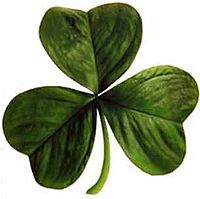

|
About Dave Kearns follow me on Twitter IdM Journal Wired Windows Dave Kearns' Fusion newsletters on:
|
Thursday, December 21, 2006
Saint Patrick on PersonaI was contemplating the Christmas season and what it means to those of a religious bent when it occurred to me that the idea of “persona” – different facets of a single identity – is thousands of years older than our digital world.A few years ago I defined persona as “an aspect of identity in a specific situation: office persona, parenting persona and so on. “ Since then, I’ve refined it to be a collection of related attribute-value pairs, a subset of all of the attributes that make up an entity’s identity. Over 1500 years ago, St. Patrick was attempting to convert Ireland’s Druids to Roman  Catholicism. One tool he used was the shamrock, a sacred plant to the Druids. Patrick illustrated the doctrine of the Holy Trinity (one God, three aspects: the father, the son and the holy spirit) by noting that the plant has three leaves but only one stem. Today we could say that the entity, God, has three personae: the Father, the Son and the Holy Spirit. Each persona emphasizes a particular set of God’s attributes yet each persona is still the entity, God. Catholicism. One tool he used was the shamrock, a sacred plant to the Druids. Patrick illustrated the doctrine of the Holy Trinity (one God, three aspects: the father, the son and the holy spirit) by noting that the plant has three leaves but only one stem. Today we could say that the entity, God, has three personae: the Father, the Son and the Holy Spirit. Each persona emphasizes a particular set of God’s attributes yet each persona is still the entity, God.That led me to take another look at the God of the Old Testament – God the Father in the Christian tradition. But also Yahweh to the Jews and Allah to the Muslims. Each of these is merely a persona of the entity God with a mildly differing set of attributes interpreted by those humans known, collectively, as prophets. One God, multiple personae. But, in looking farther afield, we find it isn’t only the near-Eastern monotheistic religions which offer as a God-entity with multiple personae. Hinduism is also based on this concept. As Hindu Wisdom puts it: Hinduism is often labeled as a religion of 330 million gods. This misunderstanding arises when people fail to grasp the symbolism of the Hindu pantheon. Hindus worship the nameless and formless Supreme Reality (Bramh) by various names and forms. These different aspects of one reality are symbolized by the many gods and goddesses of Hinduism. For example, Brahma (not to be confused with the over-arching Bramh) is that reality in its role as creator of the universe; in Vishnu it is seen as the preserver and the upholder of the universe; and Shiva is that same reality viewed as the principle of transcendence which will one day 'destroy' the universe. These are the Trimurti, the ' three forms,' and they are not so much different gods as different ways of looking at the same God. Each emphasizes a particular aspect or function of the one reality. The forms are many, the reality is one; the principle is very deeply rooted in Hindu thought, and was stated at the very outset in the Rg Veda: Explaining the concept of persona is never easy, but at least this might give you an edge with the practicing religious folks in your organization. Comments: Post a Comment
© 2003-2006 The Virtual Quill, All Rights Reserved
Home
|
|